10.2 What Is Intelligence?

Michael Jordan was an extraordinary basketball player and a mediocre baseball player. So was he or wasn’t he a great athlete?
PATRICK MURPHY-RACEY/SPORTS ILLUSTRATED/GETTY IMAGES
During the 1990s, Michael Jordan won the National Basketball Association’s Most Valuable Player award five times, led the Chicago Bulls to six league championships, and had the highest regular season scoring average in the history of the game. The Associated Press named him the second-greatest athlete of the century, and ESPN named him the first. So when Jordan quit professional basketball in 1993 to join professional baseball, he was as surprised as anyone to find that he–well, there’s really no way to say this nicely–sucked. One of his teammates lamented that Jordan “couldn’t hit a curveball with an ironing board,” and a major-league manager called him “a disgrace to the game” (Wulf, 1994). Given his lackluster performance, it’s no wonder that Jordan gave up baseball after just one season and returned to basketball, where he led his team to three consecutive championships.
Michael Jordan’s brilliance on the basketball court and his mediocrity on the baseball field proved beyond all doubt that these two sports require different abilities that are not necessarily possessed by the same individual. But if basketball and baseball require different abilities, then what does it mean to say that someone is the greatest athlete of the century? Is athleticism a meaningless abstraction? The science of intelligence has grappled with a similar question for more than a hundred years. As we have seen, intelligence test scores predict important outcomes, from academic success to longevity. But is that because they measure a real property of the human mind, or is intelligence just a meaningless abstraction?
A Hierarchy of Abilities
Charles Spearman was a student of Wilhelm Wundt (who founded the first experimental psychology laboratory), and he set out to answer precisely this question. Spearman invented a technique known as factor analysis, which is a statistical technique that explains a large number of correlations in terms of a small number of underlying factors. (We’ll get into a bit more detail about this in the next section.) Although Spearman’s technique was complex, his reasoning was simple: If there really is a single, general ability called intelligence that enables people to perform a variety of intelligent behaviors, then those who have this ability should do well at just about everything and those who lack it should do well at just about nothing. In other words, if intelligence is a single, general ability, then there should be a very strong positive correlation between people’s performances on all kinds of tests.

Dr. Jennifer Richeson received a so-called genius award from the MacArthur Foundation for her research in social psychology. Spearman’s notion of general ability suggests that because she’s really good at science, then she’s probably at least pretty good at many other things, such as dancing. And in fact, she is!
Courtesy Chris Queen
To find out if there was, Spearman (1904) measured how well school-age children could discriminate small differences in color, auditory pitch, and weight, and he then correlated these scores with the children’s grades in different academic subjects as well as with their teachers’ estimates of their intellectual ability. His research revealed two things. First, it revealed that most of these measures were indeed positively correlated: Children who scored high on one measure (e.g., distinguishing the musical note C-sharp from D) tended to score high on the other measures (e.g., solving algebraic equations). Some psychologists have called this finding “the most replicated result in all of psychology” (Deary, 2000, p. 6), and in fact, even mice show a strong positive correlation between performances on different kinds of cognitive tests (Matzel et al., 2003). Second, Spearman’s research revealed that although different measures were positively correlated, they were not perfectly correlated: The child who had the very highest score on one measure didn’t necessarily have the very highest score on every measure. Spearman combined these two facts into a two-factor theory of intelligence, which suggested that every task requires a combination of a general ability (g) and skills that are specific to the task (s).
| Primary Mental Ability |
Description |
| Word Fluency |
Ability to solve anagrams and to find rhymes, etc. |
| Verbal Comprehension |
Ability to understand words and sentences |
| Numerical Ability |
Ability to make mental and other numerical computations |
| Spatial Visualization |
Ability to visualize a complex shape in various orientations |
| Associative Memory |
Ability to recall verbal material, learn pairs of unrelated words, etc. |
| Perceptual Speed |
Ability to detect visual details quickly |
| Reasoning |
Ability to induce a general rule from a few instances |
Table 10.1: Thurstone’s Primary Mental Abilities
As sensible as Spearman’s conclusions were, not everyone agreed with them. Louis Thurstone (1938) noticed that, although scores on most tests were indeed positively correlated, scores on one kind of verbal test were more highly correlated with scores on another kind of verbal test than they were with scores on perceptual tests. Thurstone took this “clustering of correlations” to mean that there was actually no such thing as g and that there were, instead, a few stable and independent mental abilities such as perceptual ability, verbal ability, and numerical ability, which he called the primary mental abilities. These primary mental abilities were neither general like g (e.g., a person might have strong verbal abilities and weak numerical abilities), nor specific like s (e.g., a person who had strong verbal abilities tended both to speak and read well). In essence, Thurstone argued that just as we have games called baseball and basketball but no game called athletics, so we have abilities such as verbal ability and perceptual ability but no general ability called intelligence. TABLE 10.2 shows the primary mental abilities that Thurstone identified.
How was the debate between Spearman and Thurstone resolved?
The debate among Spearman, Thurstone, and other mathematical giants was quite technical, and it raged for half a century as psychologists debated the existence of g. But in the 1980s, a new mathematical technique called confirmatory factor analysis brought the debate to a quiet close by revealing that Spearman and Thurstone had each been right in his own way. Specifically, this new technique showed that the correlations between scores on different mental ability tests are best described by a three-level hierarchy (see FIGURE 10.2) with a general factor (like Spearman’s g) at the top, specific factors (like Spearman’s s) at the bottom, and a set of factors called group factors (like Thurstone’s primary mental abilities) in the middle (Gustafsson, 1984). A reanalysis of massive amounts of data collected over 60 years from more than 130,000 healthy adults, schoolchildren, infants, college students, people with learning disabilities, and people with mental and physical illnesses has shown that almost every study done over the past half century results in a three-level hierarchy of this kind (Carroll, 1993). This hierarchy suggests that people have a very general ability called intelligence, which is made up of a small set of middle-level abilities, which are made up of a large set of specific abilities that are unique to particular tasks. Although this resolution to a hundred years of disagreement is not particularly exciting, it appears to have the compensatory benefit of being true.
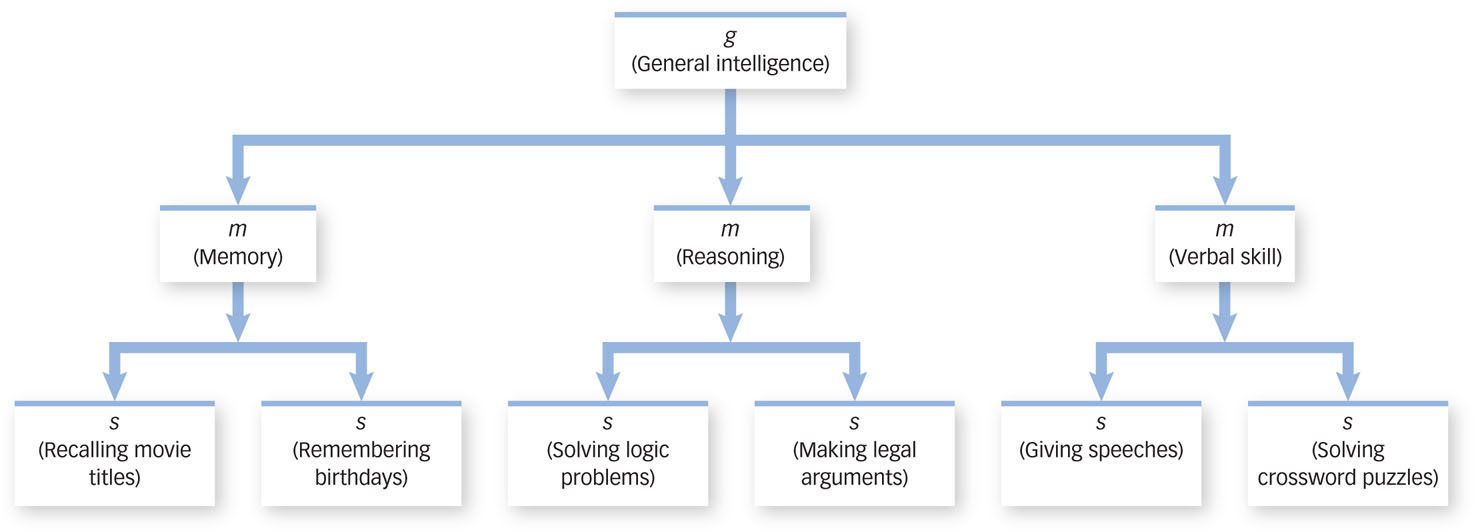
Figure 10.2: A Three-Level Hierarchy Most intelligence test data are best described by a three-level hierarchy with general intelligence (g) at the top, specific abilities (s) at the bottom, and a small number of middle-level abilities (m) (sometimes called group factors) in the middle.
The Middle-Level Abilities
Michael Jordan played basketball much better than baseball, but he played both sports much better than most people can. His specific abilities allowed him to be more successful at one sport than another, but his general ability allowed him to outperform 99.9% of the world’s population on both the court and the field. It is easy to see that Michael Jordan had both specific abilities (dribbling) and a general ability (athleticism), but it is not so easy to say precisely what his middle-level abilities were. Should we draw a distinction between speed and power, between guile and patience, or between the ability to work with a team or perform as an individual? Should we describe his athleticism as a function of 3 middle-level abilities or 4? or 6? or 92?
Similar questions arise when we consider intelligence. Most psychologists agree that there are very specific mental abilities as well as a very general mental ability and that one of the important challenges is to describe the middle-level abilities that lie between them. Some psychologists have taken a data-based approach to this problem by starting with people’s responses on intelligence tests and then looking to see what kinds of independent clusters these responses form. Other psychologists have taken a theory-based approach to this problem by starting with a broad survey of human abilities and then looking to see which of these abilities intelligence tests measure–or fail to measure. These approaches have led to rather different suggestions about the best way to describe the middle-level abilities that constitute intelligence.
The Data-Based Approach
One way to determine the nature of the middle-level abilities is to start with the data and go where they lead us. Just as Spearman and Thurstone did, we could compute the correlations between the performances of a large number of people on a large number of tests and then see how those correlations cluster. For example, imagine that we tested how quickly and well a large group of people could (a) balance teacups, (b) understand Shakespeare, (c) swat flies, and (d) sum the whole numbers between 1 and 1,000. Now imagine that we computed the correlation between scores on each of these tests and observed a pattern of correlations like the one shown in FIGURE 10.3a. What would this pattern tell us?
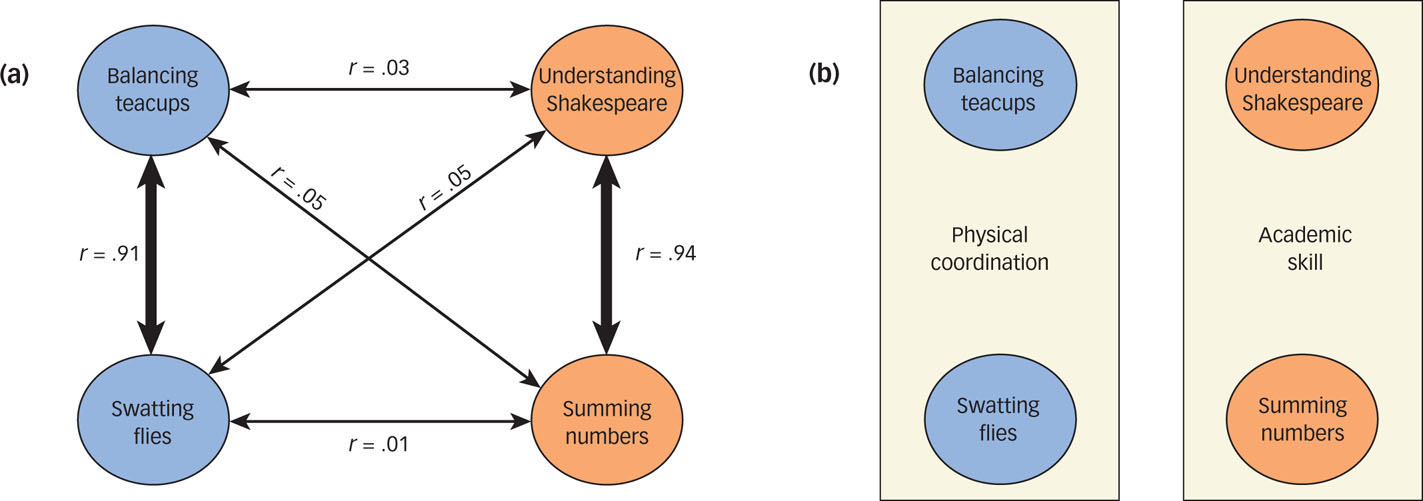
Figure 10.3: Patterns of Correlation Can Reveal Middle-Level Abilities. The pattern of correlations shown in (a) suggests that these four specific abilities can be thought of as instances of the two middle-level abilities, as shown in (b) physical coordination and academic skill.
How do patterns of correlation reveal the middle-level abilities?
This pattern suggests that a person who can swat flies well can also balance teacups well and that a person who can understand Shakespeare well can also sum numbers well, but that a person who can swat flies well and balance teacups well may or may not be able to sum numbers or understand Shakespeare well. From this pattern, we could conclude that there are two middle-level abilities (shown in FIGURE 10.3b), which we might call physical coordination (the ability that allows people to swat flies and balance teacups) and academic skill (the ability that allows people to understand Shakespeare and sum numbers). This pattern suggests that different specific abilities such as fly swatting and teacup balancing are made possible by a single middle-level ability called physical coordination, and that this middle-level ability is unrelated to the other middle-level ability, academic skill, which enables people to sum numbers and understand Shakespeare. As this example reveals, simply by examining the pattern of correlations between different tests, we can divine the nature and number of the middle-level abilities.
In the real world, of course, there are more than four tests. So what kinds of patterns do we observe when we calculate the correlations between the tests of mental ability that psychologists actually use? This is precisely what psychologist John Carroll (1993) set out to discover in his landmark analysis of intelligence test scores from nearly 500 studies conducted over a half century. Carroll found that the pattern of correlations among these tests suggested the existence of eight independent middle-level abilities: memory and learning, visual perception, auditory perception, retrieval ability, cognitive speediness, processing speed, crystallized intelligence, and fluid intelligence.
Although most of the abilities on this list are self-explanatory, the last two are not. Fluid Intelligence is the ability to see abstract relationships and draw logical inferences; crystallized intelligence is the ability to retain and use knowledge that was acquired through experience (Horn & Cattell, 1966). If we think of the brain as an information-processing device, then crystallized intelligence refers to the “information” part and fluid intelligence refers to the “processing” part (Salthouse, 2000). Whereas crystallized intelligence is generally assessed by tests of vocabulary, factual information, and so on, fluid intelligence is generally assessed by tests that pose novel, abstract problems that must be solved under time pressure, such as Raven’s Progressive Matrices Test (shown in FIGURE 10.4). The distinction between these two kinds of intelligence is not just conceptual; it is neural. Tests of fluid intelligence and crystallized intelligence seem to activate different regions of the brain, which may explain why impairment of one kind of intelligence does not necessitate impairment of the other. For example, autism and Alzheimer’s disease both impair crystallized intelligence, but leave fluid intelligence virtually intact, whereas damage to the prefrontal cortex (whether through accident or normal aging) does the opposite (Blair, 2006).
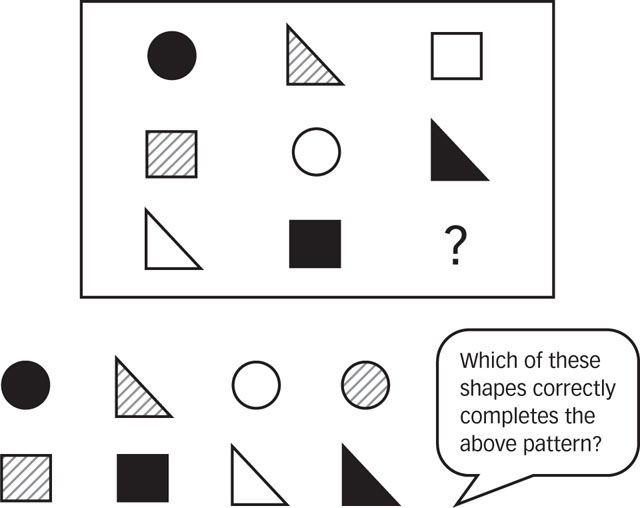
Figure 10.4: Raven’s Progressive Matrices Test This item from Raven’s Progressive Matrices Test measures nonverbal reasoning abilities and is unlikely to be culturally biased.
The Theory-Based Approach
What are the advantages of a theory-based approach to intelligence?

Ten years after being diagnosed with Alzheimer’s disease, psychology professor Richard Taylor has become a leading advocate for people who have the disease. Although Alzheimer’s impairs crystallized intelligence, it leaves fluid intelligence relatively intact (Matsuda & Saito, 1998).
Courtesy Richard Taylor
The data-based approach attempts to discover the middle-level abilities by analyzing people’s responses to questions on intelligence tests. The good thing about this approach is that its conclusions are based on hard evidence. But the bad thing about this approach is that it is incapable of discovering any middle-level ability that the intelligence tests it uses didn’t already measure (Stanovich, 2009). For example, no intelligence test asks people to find three new uses for an origami fish or to answer the question, “What is the question you thought you’d be asked but weren’t?” As a result, the scores from these tests may be incapable of revealing the middle-level abilities such as imagination or creativity. Are there middle-level abilities to which the data-based approach is blind?
Psychologist Robert Sternberg (1999) has argued that, in fact, there are three kinds of intelligence, only one of which is measured by standard intelligence tests. Analytic intelligence is the ability to identify and define problems and to find strategies for solving them; practical intelligence is the ability to apply and implement these solutions in everyday settings; and creative intelligence is the ability to generate solutions that other people do not. According to Sternberg, standard intelligence tests typically confront people with clearly defined problems that have one right answer and then supply all the information needed to solve them. These kinds of problems measure analytic intelligence. But everyday life confronts people with situations in which they must formulate the problem, find the information needed to solve it, and then choose among multiple acceptable solutions. These situations require practical and creative intelligence. Some studies suggest that these different kinds of intelligence are independent. For example, workers at milk-processing plants develop complex strategies for efficiently combining partially filled cases of milk, and not only do they outperform highly educated white-collar workers, but their performance is also unrelated to their scores on intelligence tests, suggesting that practical and analytic intelligence are not the same thing (Scribner, 1984). Sternberg has argued that tests of practical intelligence are better than tests of analytic intelligence at predicting a person’s job performance, though such claims have been criticized (Brody, 2003; Gottfredson, 2003).

DAVID SIPRESS/THE NEW YORKER COLLECTION/CARTOONBANK.COM
What skills are particularly strong in emotionally intelligent people?
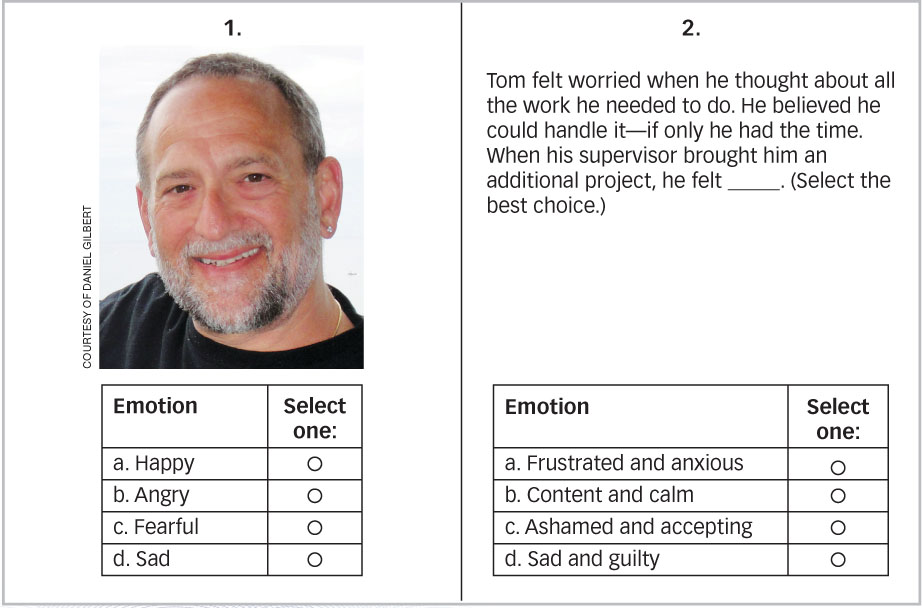
Two items from a test of emotional intelligence. Item 1 measures the accuracy with which a person can read emotional expressions (left). Item 2 measures the ability to predict emotional responses to external events (right). The correct answer to both questions is A.
From Mayer, Roberts, & Barsade, 2008.
Of course, not all of the problems that intelligence enables us to solve are analytical, practical, or creative. For instance, how do you tell a friend that she talks too much without hurting her feelings? How do you cheer yourself up after failing a test? How do you know whether you are feeling anxious or angry? Psychologists John Mayer and Peter Salovey define emotional intelligence as the ability to reason about emotions and to use emotions to enhance reasoning (Mayer, Roberts, & Barsade, 2008; Salovey & Grewal, 2005). Emotionally intelligent people know what kinds of emotions a particular event will trigger, they can identify, describe, and manage their emotions, they know how to use their emotions to improve their decisions, and they can identify other people’s emotions from facial expressions and tones of voice. Furthermore, they do all this quite easily, which is why emotionally intelligent people show less neural activity when solving emotional problems than emotionally unintelligent people do (Jausovec & Jausovec, 2005; Jausovec, Jausovec, & Gerlic, 2001). These skills are also quite important for social relationships. Emotionally intelligent people have better social skills and more friends (Eisenberg et al., 2000; Mestre et al., 2006; Schultz, Izard, & Bear, 2004), they are judged to be more competent in their interactions (Brackett et al., 2006), and they have better romantic relationships (Brackett, Warner, & Bosco, 2005) and workplace relationships (Elfenbein et al., 2007; Lopes et al., 2006). Given all this, it isn’t surprising that emotionally intelligent people tend to be happier (Brackett & Mayer, 2003; Brackett et al., 2006) and more satisfied with their lives (Ciarrochi, Chan, & Caputi, 2000; Mayer, Caruso, & Salovey, 1999).
How does the concept of intelligence differ across cultures?
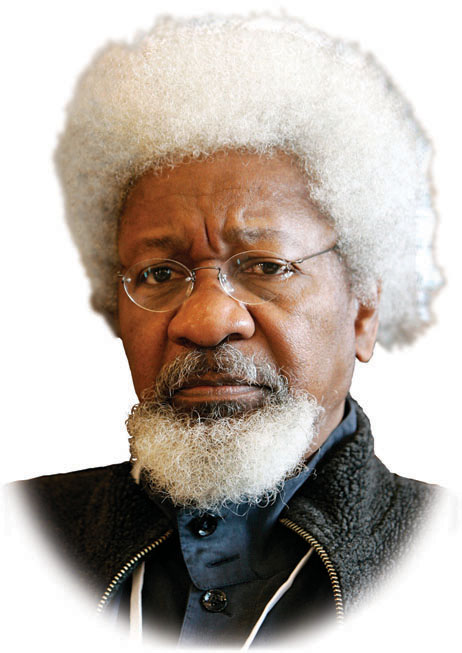
Africans tend to think of intelligent people as deliberate and quiet. Thought is hallowed in the lean oil of solitude, wrote Nigerian poet Wole Soyinka, who spent nearly 2 years in solitary confinement for his radical writing. A decade later he won the Nobel Prize in Literature.
AP PHOTO/FRANCOIS MORI
The data-based approach is also blind to middle-level abilities that are valued in cultures where intelligence tests are not common. For instance, Westerners regard people as intelligent when they speak quickly and often, but Africans regard people as intelligent when they are deliberate and quiet (Irvine, 1978). The Confucian tradition emphasizes the ability to behave properly, the Taoist tradition emphasizes humility and self-knowledge, and the Buddhist tradition emphasizes determination and mental effort (Yang & Sternberg, 1997). Unlike Western societies, many African and Asian societies conceive of intelligence as including social responsibility and cooperativeness (Azuma & Kashiwagi, 1987; Serpell, 1974; White & Kirkpatrick, 1985), and the word for intelligence in Zimbabwe, ngware, means to be wise in social relationships. Definitions of intelligence may even differ within a culture: Californians of Latino ancestry are more likely to equate intelligence with social competence, whereas Californians of Asian ancestry are more likely to equate it with cognitive skill (Okagaki & Sternberg, 1993). Some researchers take all this to mean that different cultures have radically different conceptualizations of intelligence, but others are convinced that what appear to be differences in the conceptualization of intelligence are really just differences in language. They argue that every culture values the ability to solve important problems and that what really distinguishes cultures is the kinds of problems that are considered to be important.
 People who score well on one test of mental ability usually score well on others, which suggests that there is a property called g (general intelligence).
People who score well on one test of mental ability usually score well on others, which suggests that there is a property called g (general intelligence). People who score well on one test of mental ability don’t always score well on others, which suggests that there are properties called s (specific abilities).
People who score well on one test of mental ability don’t always score well on others, which suggests that there are properties called s (specific abilities). Research reveals that between g and s are several middle-level abilities.
Research reveals that between g and s are several middle-level abilities. The data-based approach suggests that there are eight middle-level abilities.
The data-based approach suggests that there are eight middle-level abilities. The theory-based approach suggests that there may be middle-level abilities that standard intelligence tests don’t measure, such as practical, creative, and emotional intelligence. Non-Western cultures may include measures of social responsibility and cooperation in their definitions of intelligence.
The theory-based approach suggests that there may be middle-level abilities that standard intelligence tests don’t measure, such as practical, creative, and emotional intelligence. Non-Western cultures may include measures of social responsibility and cooperation in their definitions of intelligence.









 People who score well on one test of mental ability usually score well on others, which suggests that there is a property called g (general intelligence).
People who score well on one test of mental ability usually score well on others, which suggests that there is a property called g (general intelligence). People who score well on one test of mental ability don’t always score well on others, which suggests that there are properties called s (specific abilities).
People who score well on one test of mental ability don’t always score well on others, which suggests that there are properties called s (specific abilities). Research reveals that between g and s are several middle-
Research reveals that between g and s are several middle- The data-
The data- The theory-
The theory-